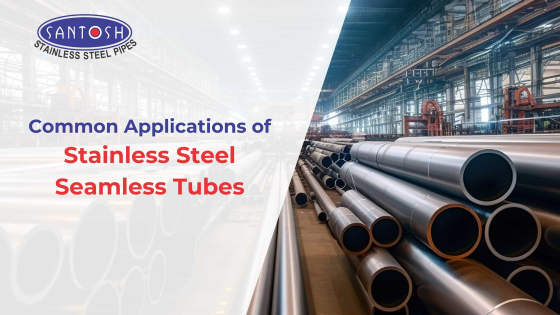
Since most people confuse piping and tubing as being the same thing, there is some confusion about how to use the two products. Both products are expected to serve the same duties since they have round or round cross-sections. Unlike pipes, which only come in one shape, stainless steel seamless tubes can also be square, rectangular, or round. Pipes are not utilised for structural purposes; rather, it is a conveyance device for transferring gases and liquids. Its interior diameter serves as the measurement. The tubing's outside diameter and wall thickness are used to determine how strong it is.
Due to its strength, corrosion resistance, and low maintenance requirements, stainless steel is an excellent material for both manufacturers and construction companies. Stainless steel seamless tubing must be precisely sized depending on the outside diameter and wall thickness for structural applications. The application determines the type of tubing. Tubes might be fractional, hypodermic, square, or Metric in shape.
Steel is one of the most versatile building materials in existence. Stainless steel seamless tubes are a good example of this. From basic construction to the petrochemical industry, steel tubes can be employed in a variety of industries. Steel tubes are a great choice since they can resist high pressure levels and are durable. Steel tubes have undergone extensive testing and have been produced to stringent standards to ensure their strength in service.
Uses for Stainless Steel Tubing
As was already said, stainless steel tubing is utilised in a wide range of industries and buildings, including factory equipment and automobile mufflers. In many situations, stainless steel tubes play the same function. The objective is to transfer information or control the flow of a gas or liquid. Stainless steel seamless tubing can withstand hot gases and corrosive liquids without degrading. The possibilities for stainless steel are endless and are only constrained by one's creativity, ingenuity, and financial means.
The sole restriction on the stainless steel seamless tubing application is the amount of money allotted for the project's tubing. Additionally, stainless steel tubing may be exposed to the elements for extended periods of time without rusting or degrading. Due to its resistance to lifespan, stainless steel tubing is used in several goods and industries. In wet industries with concrete floors, in the manufacture of tents and other outdoor and hunting gear, as well as in kitchenware with stainless steel sanitary tubing, stainless steel tubes are used.
Stainless steel tubing advantages
Stainless steel seamless tubes have many advantages over conventional metals. In addition to being strong, stainless steel tubing has the following advantages:
-
it can be formed into a variety of grades and tube radii
-
it can transport cold or hot liquids and gases
-
it is resistant to rot when exposed to most chemicals
-
It can be formed at a lower cost for lower pressure systems.
Steel tubes are used in almost every industry, thus it is not surprising. The following list of industries includes some of its stainless steel seamless tube applications also explained to you with some real time industrial examples.
1. Healthcare
Steel tubes are used to construct hygienic medical devices, apparatus, equipment, and other vital patient care infrastructure. Medical equipment constructed of tubular steel should be dependable and designed to the highest standards possible when lives are on the line. This is done to help in circumstances that call for both critical care and surgical accuracy. Tubular steel is used in many healthcare facilities, including hospitals, clinics, birthing centres, and blood banks. Additionally, tubular steel is frequently used in the construction of components for medical devices such as IV stands, wheelchairs, gurneys, and small surgical instruments.
2. Fabrication
A wide range of building styles, from low-rise to high-rise buildings, can use tubular steel structurally. They can be used in residential environments as decorative beams, rafters, roof decks, frameworks, rivets, and columns. Tubular steel is a common option for inexpensive construction materials since it is widely accessible. Steel can be recycled without losing any of its functionality, thus that is true. On the other hand, steel tubes are more economical when developing a moderately priced or low-priced warehouse. Producers, suppliers, and refineries are accountable for ensuring that any scrap steel used in their operations is suitable for use in structural or even adornment applications.
3. Petrochemicals
The production of items that require the burning of fossil fuels or other high-energy processes is the main focus of the petrochemical sector. They must be able to handle these situations with the systems and components they utilise. Pipelines, heating, air conditioning, and other systems all need stainless steel seamless tubes. These steel constructions have been designed to endure biological reactions and high pressure because of the continuous fluid flow. Tubular steel can be protected from corrosion and is made to bear harsh chemical exposure and temperature changes without losing its shape or quality.
4. Automobiles
Due to their common melting point of between 1400 and 1540 degrees Celsius, tubular steel products are a popular choice for the production of automobiles. Steel tubes are used in a variety of components, including radiators, chassis, shock absorbers, and even the body and frame of the car. Because of its greater safety for drivers as well as its ability to tolerate high temperatures, steel tubes are a popular metal product.
Conclusion
In recent years, Santosh Steel has been hailed as one of the top manufacturers of stainless steel seamless tubes and pipes, with a 100% customer satisfaction record. Therefore, Santosh Steel can assist you in making the best choice if you need high-quality steel tubes for your business needs.